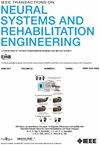Transformer-Based Approach for Predicting Transactive Energy in Neurorehabilitation
IF 4.8
2区 医学
Q2 ENGINEERING, BIOMEDICAL
IEEE Transactions on Neural Systems and Rehabilitation Engineering
Pub Date : 2024-12-11
DOI:10.1109/TNSRE.2024.3515175
引用次数: 0
Abstract
Advancements in robotic neurorehabilitation have made it imperative to enhance the safety and personalization of physical human-robot interactions (pHRI). Estimation and management of energy transfer between humans and robots is essential for enhancing safety during the rehabilitation. Traditional control methods, which rely on coordinate-based monitoring of robot velocity and external forces, often fail in unstructured environments due to their susceptibility to sensor noise and limited adaptability to individual patient needs. This paper introduces the concept of transactive energy, a coordinate-invariant entity that captures the energy dynamics between the human and the robot during robot-assisted rehabilitation and can be used for personalized robot control. However, estimation of such energy transfer is a complex process and therefore, we have developed a transformer-based model to predict the transactive potential energy. The proposed model is implemented on an ankle rehabilitation robot which is a compliant parallel robot and provides the required three rotational degrees of freedom (DOF). The model learns from the data obtained from the experiments carried out using the ankle robot with five stroke patients on two types of controllers: an impedance controller operated in zero impedance control mode and a trajectory tracking controller. This study provides a baseline, for future research on energy-based control mechanisms in pHRI applications, by utilizing the advanced deep learning models.基于变压器的神经康复交互能量预测方法
机器人神经康复技术的进步使得加强人机物理交互的安全性和个性化(pHRI)势在必行。评估和管理人与机器人之间的能量传递对于提高康复过程中的安全性至关重要。传统的控制方法依赖于基于坐标的机器人速度和外力监测,由于容易受到传感器噪声的影响,并且对个体患者需求的适应性有限,在非结构化环境中往往失败。本文介绍了交互能量的概念,交互能量是一种坐标不变的实体,它捕获了机器人辅助康复过程中人与机器人之间的能量动态,可用于机器人的个性化控制。然而,这种能量传递的估计是一个复杂的过程,因此,我们开发了一个基于变压器的模型来预测交易势能。该模型在踝关节康复机器人上实现,该机器人是一种柔性并联机器人,并提供所需的三个旋转自由度。该模型从踝关节机器人与五名中风患者在两种类型的控制器上进行的实验中获得的数据进行学习:一种是零阻抗控制模式下的阻抗控制器,另一种是轨迹跟踪控制器。通过使用先进的深度学习模型,本研究为pHRI应用中基于能量的控制机制的未来研究提供了基础。
本文章由计算机程序翻译,如有差异,请以英文原文为准。
求助全文
约1分钟内获得全文
求助全文
来源期刊
CiteScore
8.60
自引率
8.20%
发文量
479
审稿时长
6-12 weeks
期刊介绍:
Rehabilitative and neural aspects of biomedical engineering, including functional electrical stimulation, acoustic dynamics, human performance measurement and analysis, nerve stimulation, electromyography, motor control and stimulation; and hardware and software applications for rehabilitation engineering and assistive devices.

 求助内容:
求助内容: 应助结果提醒方式:
应助结果提醒方式:


